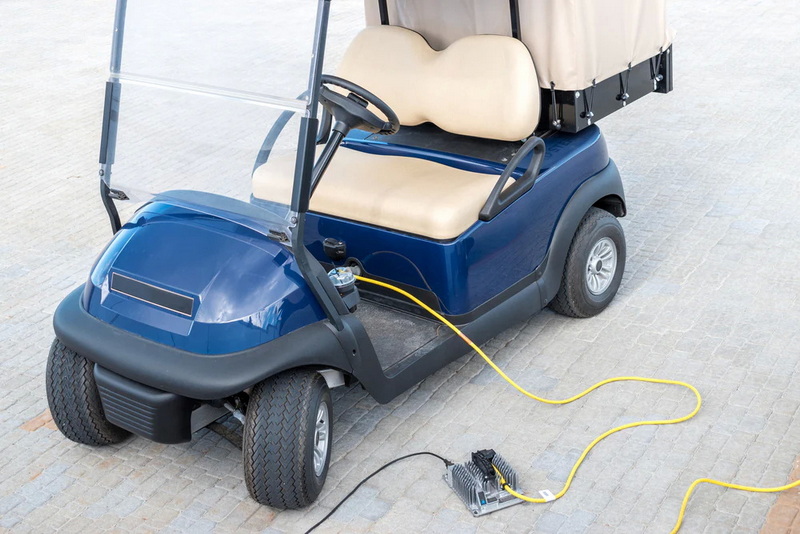Content Menu
● Typical Charging Time for Electric Golf Carts
● Factors Affecting Charging Time
>> Battery Type
>> Battery Capacity
>> Charger Type
>> Depth of Discharge
>> Battery Age and Condition
>> Temperature
● Charging Process for Electric Golf Carts
● Tips for Efficient Charging
● Understanding Battery Capacity and Range
● The Future of Electric Golf Cart Charging
● Environmental Impact of Electric Golf Carts
● Conclusion
● Frequently Asked Questions (FAQ)
>> 1. How often should I charge my electric golf cart?
>> 2. Can I overcharge my golf cart battery?
>> 3. How long does a fully charged golf cart battery last?
>> 4. Should I charge my golf cart in extreme temperatures?
>> 5. How can I tell if my golf cart battery needs replacement?
Electric golf carts have become increasingly popular due to their eco-friendly nature and low maintenance requirements. One of the most common questions that arise when considering an electric golf cart is the charging time. In this comprehensive guide, we'll explore the factors that influence charging time, provide tips for efficient charging, and answer some frequently asked questions about electric golf cart charging.

Typical Charging Time for Electric Golf Carts
The charging time for an electric golf cart can vary significantly depending on several factors. On average, a well-maintained electric golf cart battery takes between 3 and 9 hours to charge fully. However, this range can extend from as little as 1 hour to as much as 14 hours in some cases.
For most standard lead-acid batteries, which are commonly used in golf carts, the charging time typically falls within the 6 to 8-hour range. This duration allows for a complete charge cycle, ensuring that the battery reaches its full capacity.
Factors Affecting Charging Time
Several factors can influence how long it takes to charge an electric golf cart:
Battery Type
The type of battery used in your golf cart plays a significant role in determining charging time. The two main types of batteries used in electric golf carts are:
- Lead-acid batteries: These are the most common and typically take 8-12 hours to charge fully from empty.
- Lithium-ion batteries: These are more modern and efficient, often charging in 4-8 hours.
Battery Capacity
Golf cart batteries come in different voltages, commonly 36V or 48V. Higher voltage batteries generally charge faster but may require more powerful chargers.
Charger Type
The type and power of the charger used can significantly affect charging time:
- Standard chargers: These are the most common and charge at a slower rate.
- Fast chargers: These can reduce charging time by up to 50% but may affect battery longevity if used frequently.
Depth of Discharge
The extent to which the battery has been depleted before charging affects the charging time. A completely discharged battery will take longer to charge than one that is only partially depleted.
Battery Age and Condition
Older batteries or those in poor condition may take longer to charge and may not hold a charge as well as newer, well-maintained batteries.
Temperature
Extreme temperatures can affect charging efficiency. Charging is typically most efficient in moderate temperatures between 60°F and 80°F (15°C to 27°C).
Charging Process for Electric Golf Carts
To charge your electric golf cart effectively, follow these steps:
1. Park your golf cart in a well-ventilated area, preferably indoors or under cover.
2. Ensure the cart is turned off and in neutral with the parking brake engaged.
3. Locate the charging port on your golf cart (usually under the seat or on the side).
4. Connect the charger to the golf cart's charging port.
5. Plug the charger into a standard 110-volt electrical outlet.
6. The charger should indicate that it's charging (often with a light or display).
7. Allow the cart to charge for the recommended time or until the charger indicates a full charge.
Tips for Efficient Charging
To optimize your golf cart's charging process and maintain battery health:
1. Charge after each use: Even if the battery isn't fully depleted, charging after each use can help maintain battery life.
2. Avoid deep discharges: Try not to let the battery discharge below 20% capacity.
3. Use the right charger: Always use a charger designed for your specific golf cart model and battery type.
4. Keep batteries clean: Regularly clean battery terminals to ensure good connections.
5. Check water levels: For lead-acid batteries, maintain proper water levels by adding distilled water when necessary.
6. Avoid overcharging: Most modern chargers automatically stop charging when the battery is full, but it's still good practice to unplug once charging is complete.
7. Store properly: If not using the cart for extended periods, charge the battery fully and disconnect it.
Understanding Battery Capacity and Range
The battery capacity of an electric golf cart is typically measured in amp-hours (Ah). A higher Ah rating generally means a longer range between charges. Most golf carts have a range of 20-25 miles on a full charge, but this can vary based on factors such as:
- Terrain (hilly courses require more power)
- Weight of passengers and cargo
- Driving style (aggressive acceleration uses more power)
- Weather conditions (extreme temperatures can affect battery performance)
To maximize your golf cart's range:
- Drive at a steady pace
- Avoid rapid acceleration and braking
- Reduce weight where possible
- Keep tires properly inflated
- Use energy-saving features if available (e.g., regenerative braking)
The Future of Electric Golf Cart Charging
As technology advances, we're seeing improvements in both battery and charging technology for electric golf carts:
- Faster charging times: New battery technologies and chargers are reducing charging times significantly.
- Solar charging: Some golf courses are experimenting with solar-powered charging stations.
- Battery swapping: Quick-change battery systems allow for instant "recharging" by swapping out depleted batteries for fully charged ones.
- Smart charging: Advanced chargers can communicate with batteries to optimize charging cycles and extend battery life.
Environmental Impact of Electric Golf Carts
Electric golf carts offer several environmental benefits compared to their gas-powered counterparts:
- Zero emissions: Electric carts produce no direct emissions during operation.
- Reduced noise pollution: Electric motors are much quieter than gas engines.
- Energy efficiency: Electric motors convert a higher percentage of energy into motion compared to internal combustion engines.
- Potential for renewable energy: Carts can be charged using solar or wind power, further reducing their environmental impact.
Conclusion
The charging time for an electric golf cart can vary widely, typically ranging from 3 to 9 hours for a full charge. Factors such as battery type, capacity, charger efficiency, and the cart's current charge level all play a role in determining the exact charging duration. By understanding these factors and following best practices for charging and maintenance, you can ensure that your electric golf cart is always ready for use while maximizing its battery life and performance.
As technology continues to advance, we can expect to see improvements in charging times and battery longevity, making electric golf carts an even more attractive option for golf courses and personal use alike. Whether you're a golf enthusiast or a course manager, understanding the nuances of electric golf cart charging is essential for getting the most out of these eco-friendly vehicles.

Frequently Asked Questions (FAQ)
1. How often should I charge my electric golf cart?
It's best to charge your electric golf cart after each use, even if the battery isn't fully depleted. This practice helps maintain battery health and ensures your cart is always ready for use. Avoid letting the battery discharge below 20% capacity whenever possible.
2. Can I overcharge my golf cart battery?
Most modern golf cart chargers are designed to prevent overcharging by automatically shutting off or entering a maintenance mode once the battery is fully charged. However, it's still a good practice to unplug the charger once charging is complete, especially for older models without smart charging capabilities.
3. How long does a fully charged golf cart battery last?
A fully charged golf cart battery typically lasts for about 20-25 miles of driving, depending on factors such as terrain, weight, and driving style. In terms of time, this could translate to 2-3 rounds of golf or several hours of continuous use.
4. Should I charge my golf cart in extreme temperatures?
It's best to avoid charging your golf cart in extreme temperatures. Charging is most efficient and safest when done in moderate temperatures between 60°F and 80°F (15°C to 27°C). If possible, charge your cart in a temperature-controlled environment during very hot or cold weather.
5. How can I tell if my golf cart battery needs replacement?
Signs that your golf cart battery may need replacement include:
- Significantly reduced range or operating time
- Longer charging times than usual
- Difficulty holding a charge
- Visible damage or corrosion on the battery
- The battery is more than 5-7 years old (for lead-acid batteries)
If you notice these signs, it's best to have your battery professionally tested and consider replacement if necessary.









































